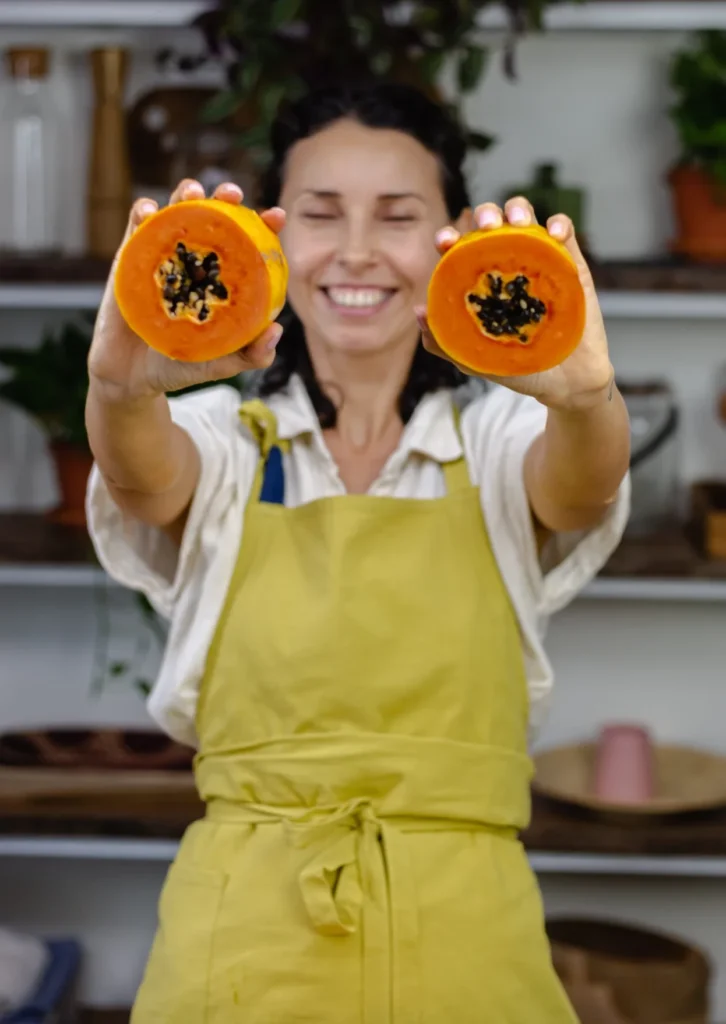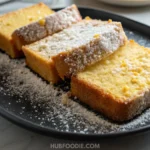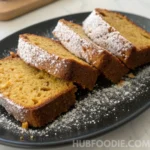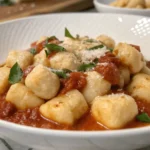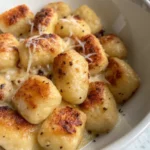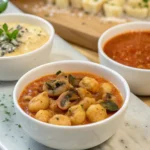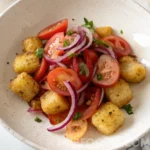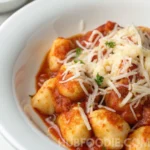The first time I made gnocchi noodles from scratch, I had no idea how much comfort those little potato pillows would bring to my table. They were tender yet chewy, almost like a cross between pasta and dumplings, and they instantly reminded me of family dinners where a warm, cozy meal felt like a hug in a bowl. I still remember flour dust floating in the air, potatoes steaming up my kitchen, and the excitement of watching the first gnocchi float to the top of the pot proof that something simple was turning into something truly special.
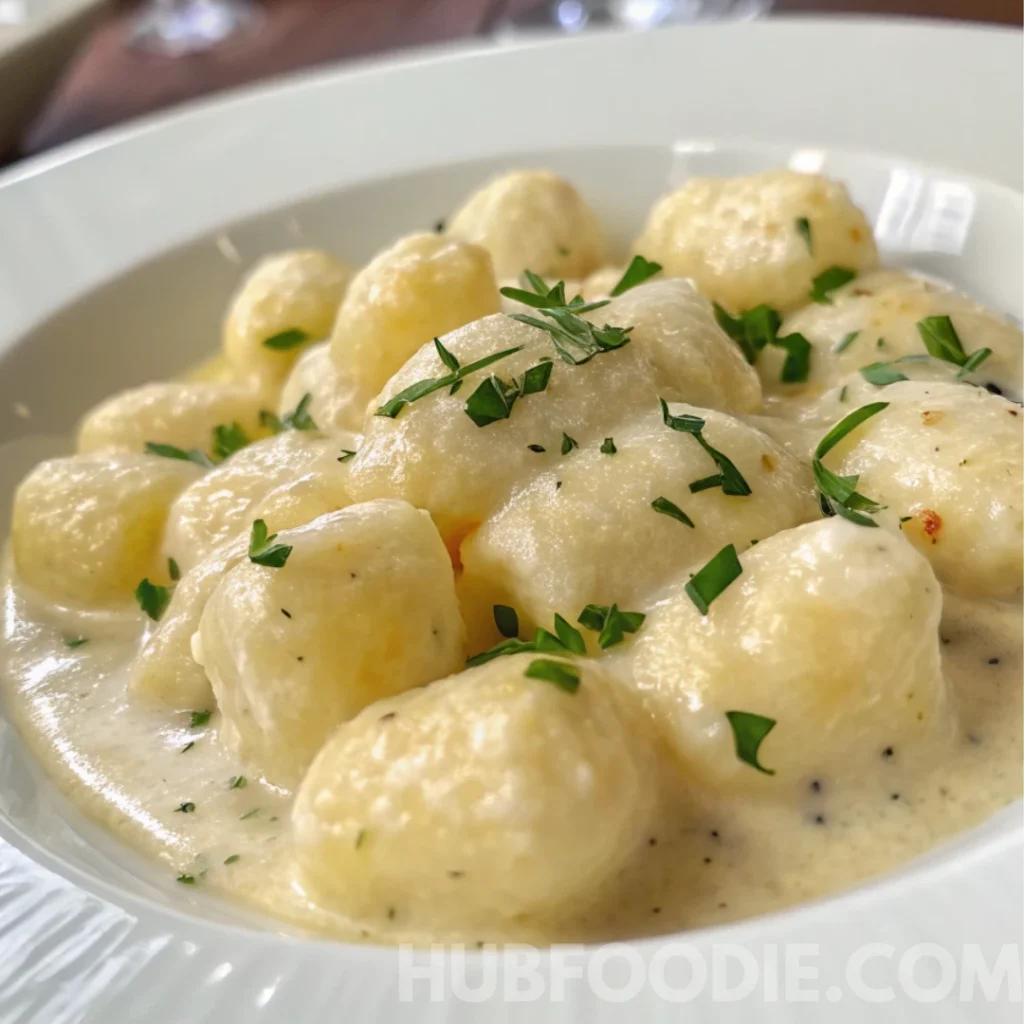
What I adore most about gnocchi is how adaptable it is. Sometimes I keep it classic with a rustic tomato sauce, similar to my go-to gnocchi marinara. Other times, I’ll toss it into a refreshing gnocchi pasta salad when I want something lighter. And when I’m craving something indulgent, a creamy cheesy gnocchi bake always hits the spot.
The beauty of gnocchi is that it bridges two worlds it has the heartiness of Italian pasta, yet it can easily lean into noodle territory. I’ve even tried a playful ramen-style version, which proves there’s no limit to how creative you can get with this dish. That’s why I call this recipe “gnocchi noodles”: it’s flexible, fun, and guaranteed to fit any mood, whether you’re craving rustic Italian flavors or a quick weeknight comfort meal.
Table of Contents
What Are Gnocchi Noodles?
If you have ever wondered whether gnocchi are pasta, dumplings, or something closer to noodles, the truth is they sit somewhere in between. Traditionally, gnocchi are small pieces of dough made from potatoes, flour, and sometimes eggs, shaped into bite-sized pillows and boiled until they float. What makes them special is their texture: soft, tender, and slightly chewy, much like noodles, which is why so many cooks refer to them as gnocchi and noodles.
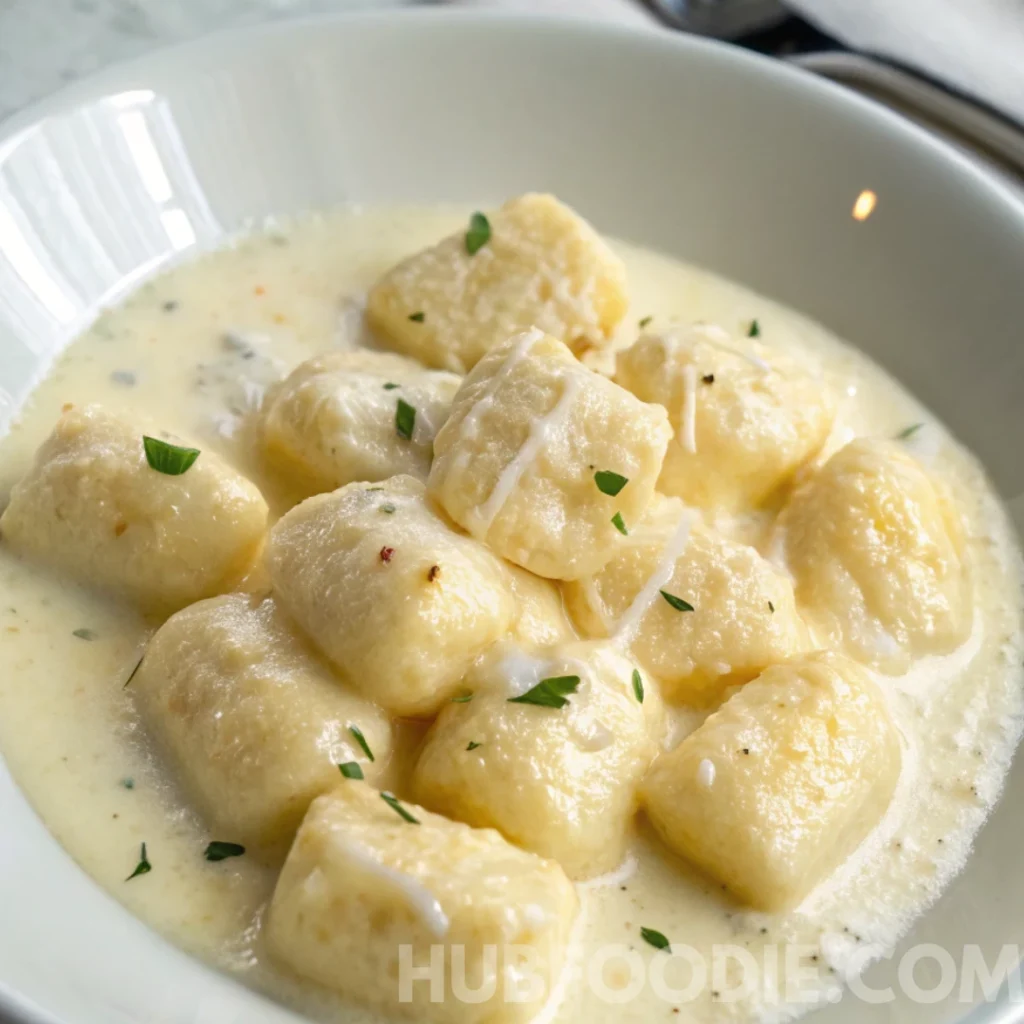
The classic Italian version is usually made with just four ingredients, but regional variations exist. In some families, an egg is always added to help bind the dough, creating a texture that feels closer to gnocchi egg noodles. Others prefer to leave the egg out entirely, producing a lighter bite. Either way, both styles celebrate the rustic roots of Italian cooking, where simple ingredients come together to create something satisfying.
Beyond Italy, gnocchi have also taken on cultural significance in South America. In Argentina and Uruguay, they are known as ñoquis or noquis, traditionally eaten on the 29th of each month as a symbol of good fortune and prosperity. Plates of gnocchi are often enjoyed with family and friends, sometimes with a coin placed under the plate to bring luck.
Today, gnocchi have crossed borders and become a global comfort food. They can be served with classic Italian sauces, tossed in Asian-inspired broths, or even stir-fried in a way that resembles noodles. This flexibility is what makes the idea of gnocchi noodles so appealing. They bring the heart of Italian tradition into modern kitchens while offering room for creativity and playful twists.
Ingredients and Substitutions
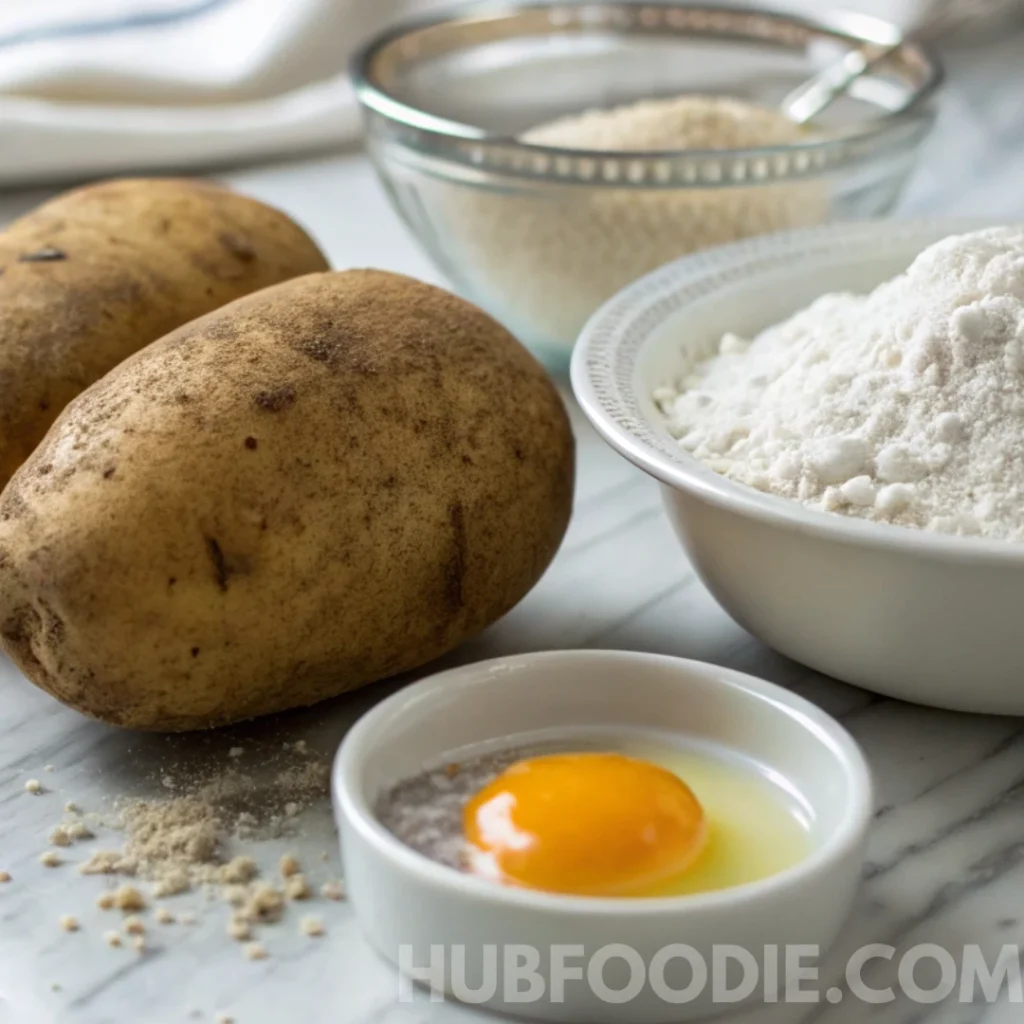
The beauty of a homemade gnocchi noodle recipe is that it requires only a few ingredients, yet each one has the power to change the final texture. Here’s a closer look at the essentials, along with smart substitutions and recipe inspiration if you want to branch out.
Potatoes
Starchy potatoes such as Yukon Gold or russet are the best choice. They give gnocchi that fluffy, melt-in-your-mouth texture. Boiling with the skins on prevents excess water absorption, while baking keeps the flesh extra dry. If you prefer something bolder, swap in sweet potatoes or even pumpkin for a colorful twist.
I often pair sweet potato versions with rich sauces like in my potato gnocchi sauce recipe, where creamy and tomato bases both work beautifully.
Flour
All-purpose flour is the standard, but 00 flour (finely milled Italian flour) makes a silkier dough. If you’re gluten-sensitive, try a mix of rice flour and potato starch for a delicate but workable dough.
For busy nights, you might opt for store-bought versions like dry pasta & noodles gnocchi. They don’t have the same pillowy softness as fresh, but they soak up sauce well and are ideal for dishes like gnocchi and pasta sauce.
Egg
Some Italian families insist on adding an egg to bind the dough, while others prefer the lighter, egg-free version. With egg, the texture is closer to gnocchi egg noodles. Without it, the dumplings are softer and more fragile.
When I want to highlight the richness of the dough, I turn to indulgent meals like cheesy gnocchi or creamy gnocchi feta, both of which benefit from sturdier gnocchi that hold sauces well.
Salt
Salt is essential both in the dough and in the cooking water. It seasons the gnocchi from within, making even the simplest plates taste vibrant.
Optional Add-ins
Once you master the basics, you can start experimenting. Ricotta-based gnocchi are softer and lighter, while spinach or herb additions add color and nutrition. In coastal Italian regions, recipes like gnocchi Amalfitani highlight bright, zesty flavors.
For inspiration on pairings, I often revisit my guide on potato gnocchi sauce ideas or what to eat with gnocchi. These help me match my homemade dough with the right sauce or side for the season.
How to Make Gnocchi Noodles
Learning how to make gnocchi noodles is one of those kitchen projects that feels surprisingly simple once you try it. The process is a little messy, a little therapeutic, and very rewarding when you see those soft pillows rise to the surface of boiling water.
Step 1: Cook the Potatoes
Start with starchy potatoes like russet or Yukon Gold. Boil them with the skins on until fork-tender, or bake them for a drier texture. Baking is my favorite method because it removes excess water, which makes the dough easier to handle.

Once cooked, peel and mash them while still warm. A potato ricer works best, but a fork or masher will do if you’re thorough. The smoother your mash, the lighter your gnocchi.
Step 2: Mix the Dough
Spread the mashed potatoes on a floured surface. Add salt, a beaten egg, and part of the flour. Gently fold the mixture until it starts to form a dough. Keep sprinkling in flour until it feels soft but not sticky.

Don’t worry if it feels too tacky at first. A bit more flour will balance it out. Avoid over-kneading; heavy-handed mixing leads to tough dumplings instead of pillowy gnocchi.

When I’m planning a cheesy dinner like my cheesy gnocchi, I’ll make the dough slightly firmer so it can hold up under rich sauce.
Step 3: Shape the Noodles
Divide the dough into smaller sections. Roll each one into a rope about an inch thick, then cut into ¾-inch pieces. Traditionally, you press them gently along the back of a fork to create ridges that hold sauce.
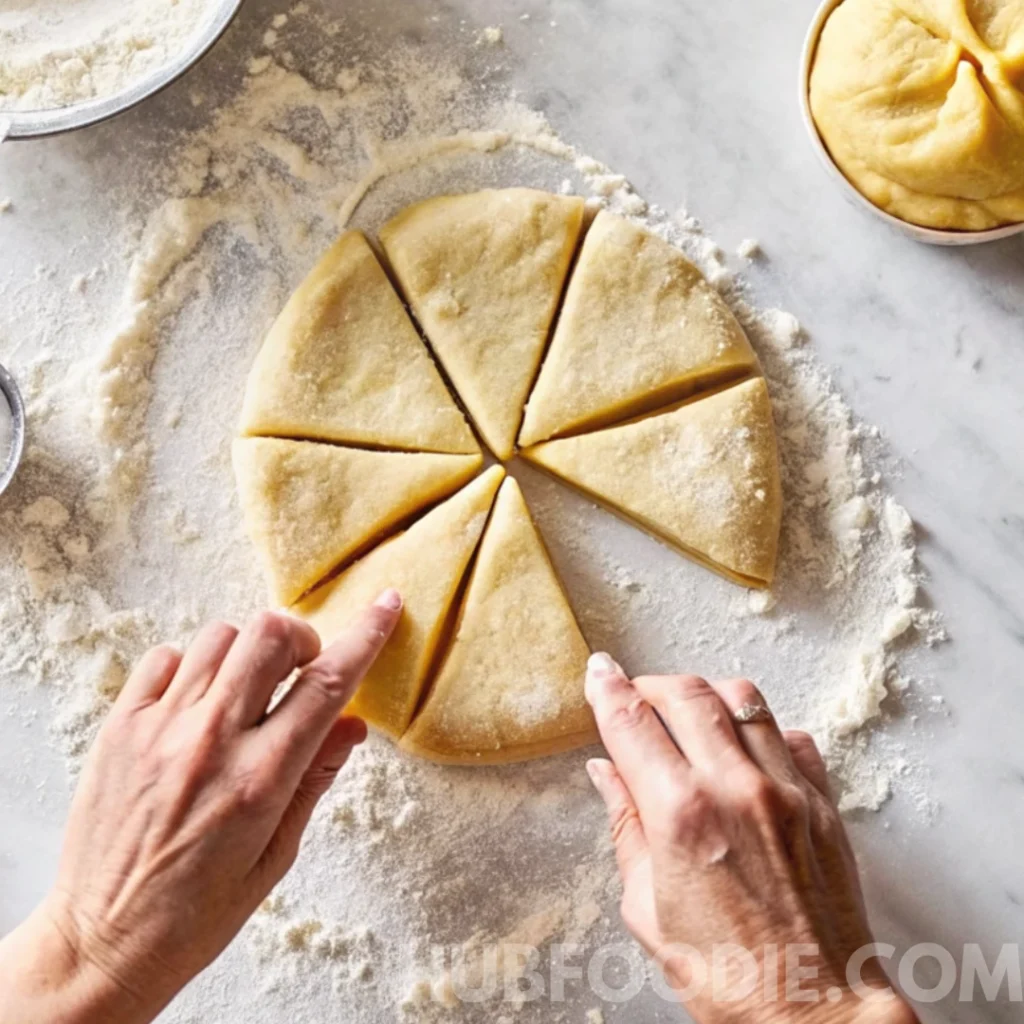
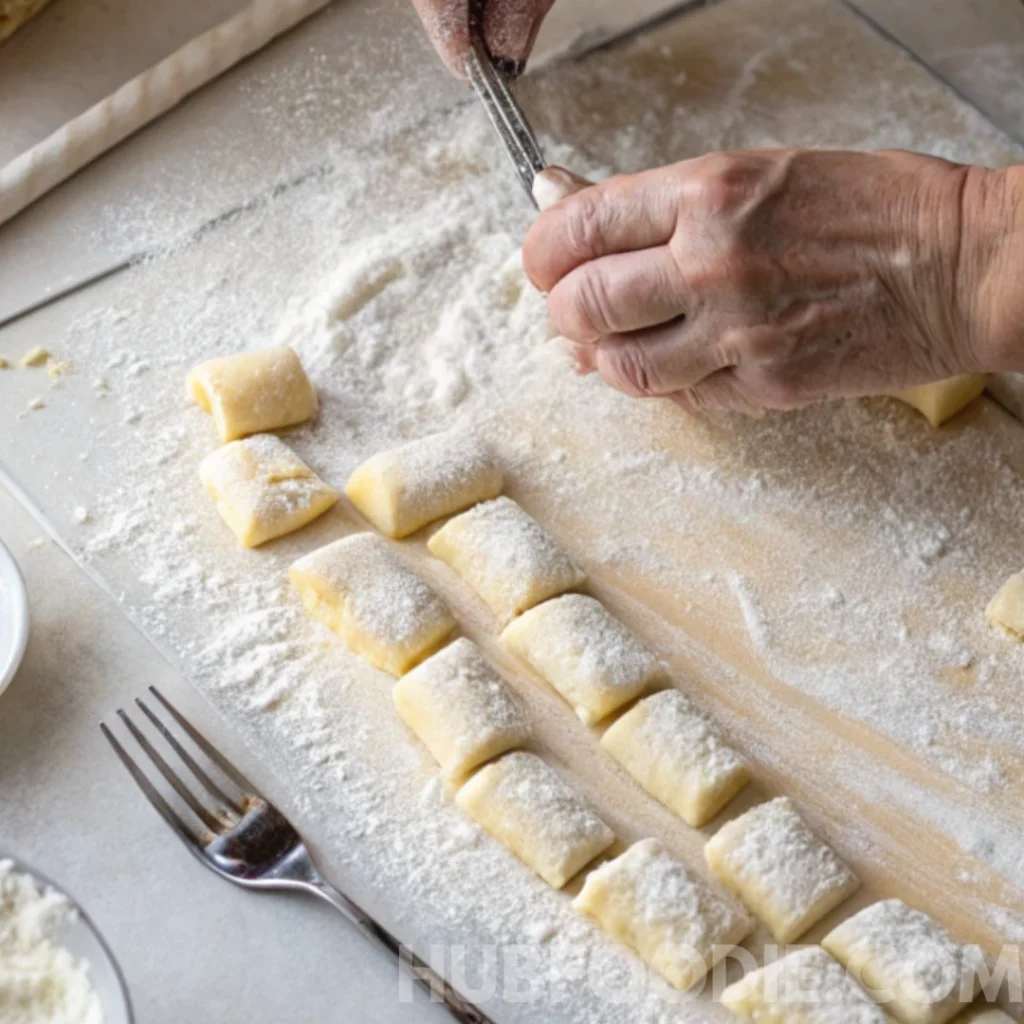

For gnocchi and noodles lovers, try rolling longer ropes and slicing them into strips to mimic the look and feel of rustic noodles. This noodle-style gnocchi is especially fun in broths or stir-fries, almost like a playful ramen noodle gnocchi.
On nights when I want a crunch, I’ll cook the dough as usual and then follow up with a quick pan fry, similar to my crispy gnocchi with tomato and red onion.
Step 4: Cook the Gnocchi
Bring a large pot of salted water to a rolling boil. Drop in a handful of gnocchi at a time. They’ll sink first, then rise to the surface when done, usually within 2 minutes. Scoop them out with a slotted spoon and move directly into your sauce.

If you want to keep things traditional, toss them into a simple gnocchi marinara for that comforting, tomato-rich flavor.
Step 5: Serve and Enjoy
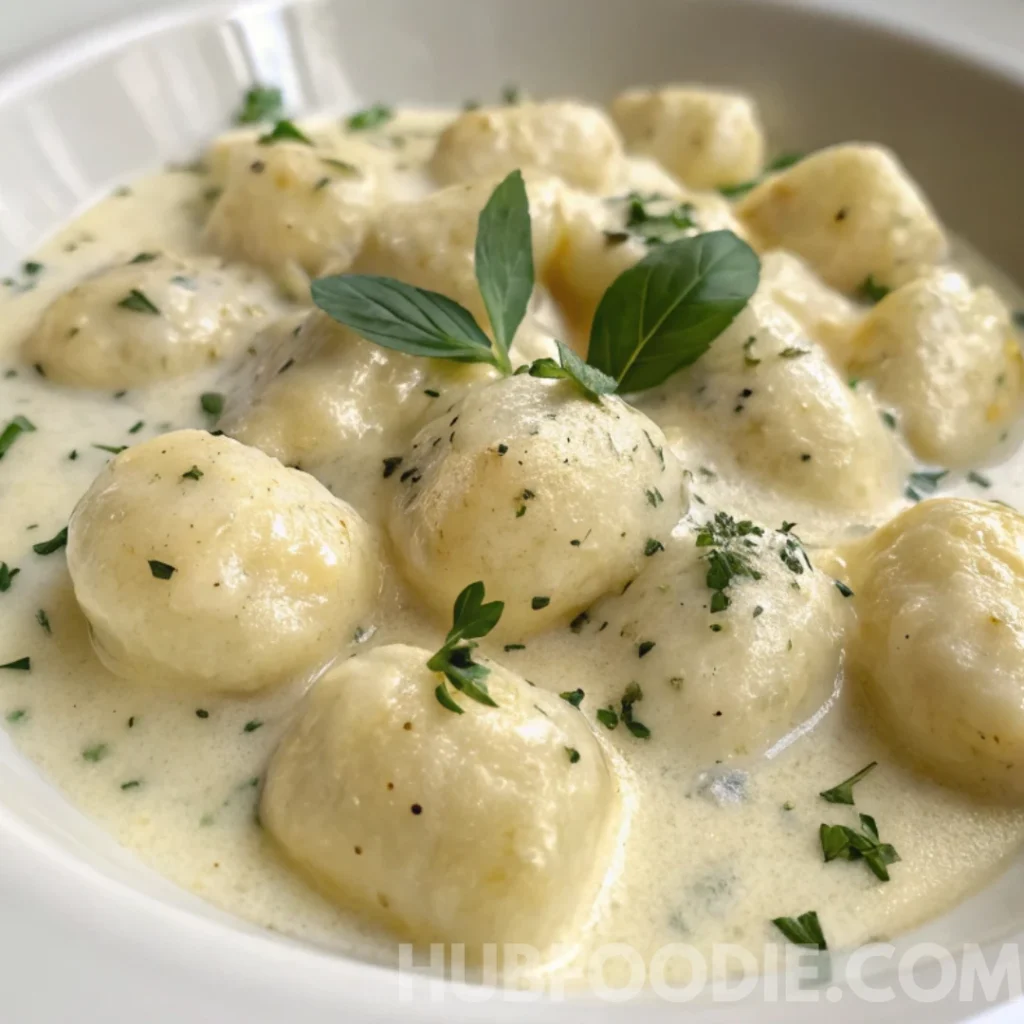
Fresh gnocchi are best served immediately. Toss them in pesto, a creamy cheese sauce, or light olive oil with fresh herbs. The noodles soak up flavor beautifully, making them a cozy meal every time.
Serving Ideas and Sauce Pairings
The real joy of making gnocchi noodles is how many different directions you can take them. Their soft, pillowy texture pairs beautifully with hearty sauces, light dressings, or even bold international flavors. Here are some of my favorite ways to serve them, each one turning the same humble dough into a completely new experience.
Classic Italian Sauces
For comfort and tradition, nothing beats tossing your gnocchi into a simple gnocchi marinara. The acidity of tomatoes balances the richness of the dough, making it a timeless pairing. If you’re looking for more variations, I often revisit my guide on potato gnocchi sauce ideas for inspiration, from creamy Alfredo to bright pesto.

Another personal favorite is gnocchi Amalfitani. With its roots in southern Italy, it layers Mediterranean flavors like tomatoes, mozzarella, and basil for a sunny, coastal twist.
Cheesy and Indulgent Options
On nights when I want something truly cozy, I lean into creamy, indulgent sauces. My cheesy gnocchi recipe is a hug in a bowl, perfect for cold evenings. Another fun spin is gnocchi feta, where the salty tang of feta cheese transforms the dish into something rich and flavorful without being heavy.
Fresh and Light Ideas
Gnocchi don’t always have to be drenched in sauce. For warm weather meals, I love making a gnocchi pasta salad. Tossed with vegetables and a zesty dressing, it feels refreshing yet filling. You can even make a lighter plate by serving gnocchi simply with olive oil, garlic, and fresh herbs.
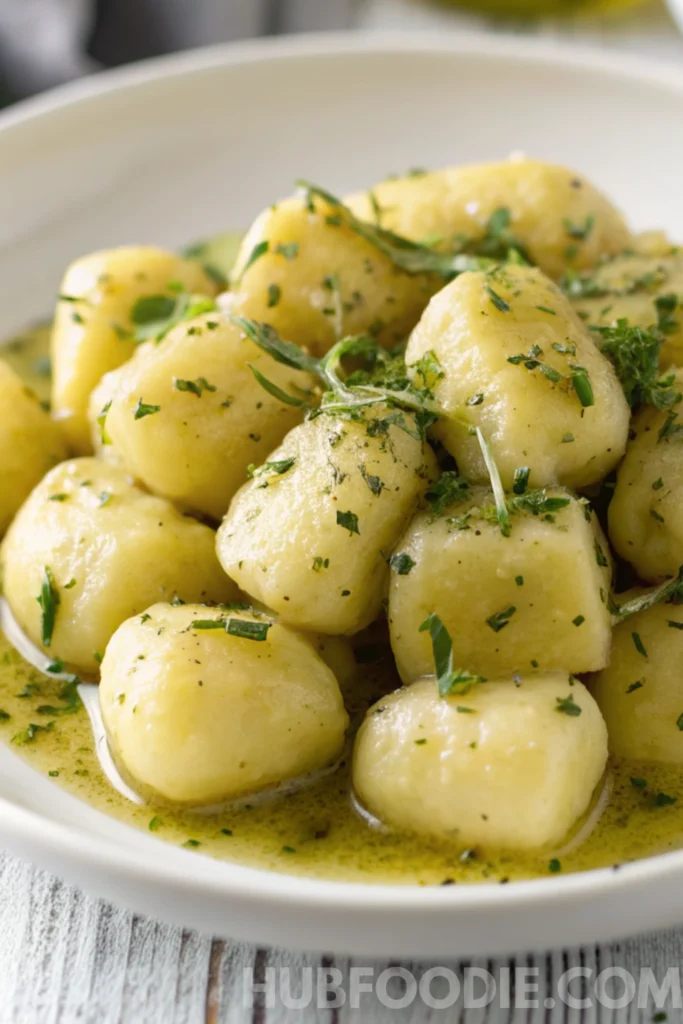
If you’re ever stuck on how to complete the meal, my guide on what to eat with gnocchi covers the best side dishes, from roasted vegetables to fresh salads, ensuring your gnocchi dinner feels balanced.
Fusion Flavors
Because gnocchi straddles the line between pasta and dumplings, it adapts beautifully to global flavors. One of my experiments was a playful ramen noodle gnocchi, tossed in soy sauce, sesame oil, and chili for a dish that felt both Italian and Asian at once. These creative twists make gnocchi an exciting option beyond the classics.
Health and Nutrition
A question I hear often is, “Is gnocchi healthier than noodles?” The answer depends on what kind of gnocchi and noodles you’re comparing. Traditional gnocchi noodles are made with potatoes, flour, and sometimes egg. That means they’re naturally lower in gluten than wheat-based pasta but often higher in carbohydrates because of the potato base.
Gnocchi vs. Pasta
A one-cup serving of gnocchi usually has fewer calories than a cup of dry pasta once cooked, but the carb content can be higher. Regular wheat pasta offers more protein, while gnocchi brings potassium and vitamin C from the potatoes. If you’re sensitive to gluten, gnocchi may be a gentler option than traditional pasta.
Gnocchi vs. Noodles
When compared to Asian noodles, gnocchi tend to be denser and more filling. Ramen and egg noodles usually contain added fats and oils, while gnocchi stay simple and clean in ingredients. If you’re watching your blood sugar, know that potatoes can spike it more quickly than durum wheat pasta. In that case, pairing gnocchi with protein-rich sauces (like meat ragu) or fiber-rich veggies can help balance the meal.
Healthier Twists
The beauty of homemade gnocchi is how adaptable it is. If you want lighter options, here are a few swaps:
- Gluten-free gnocchi: Replace all-purpose flour with a gluten-free blend.
- Vegan gnocchi: Skip the egg and use olive oil or aquafaba.
- Sweet potato gnocchi: Adds fiber and vitamin A while cutting back on starch.
- Cauliflower gnocchi: A lower-carb option that’s become popular for health-conscious cooks.
Balanced Eating
So, does gnocchi fit into a healthy lifestyle? Absolutely. As with pasta or noodles, it’s all about balance. Serve smaller portions alongside vegetables or salads, and you’ll enjoy the comfort of gnocchi without overindulging. Personally, I love pairing gnocchi with roasted vegetables or a simple green salad for a cozy but balanced dinner.
Frequently Asked Questions about Gnocchi Noodles
I get so many questions about gnocchi from readers, so let’s cover the most common ones together.
Is gnocchi a potato or pasta?
Gnocchi are usually considered a type of pasta, but they’re actually dumplings made with potatoes, flour, and sometimes egg. Think of them as sitting right between pasta and noodles soft, chewy, and perfect for sauce.
Is gnocchi healthier than noodles?
It depends. Gnocchi is lower in gluten than wheat noodles but higher in carbs because of the potato base. If you’re looking for balance, pair gnocchi with vegetables or lean protein. Healthier versions like cauliflower gnocchi or sweet potato gnocchi are great options.
Can I use gnocchi instead of pasta?
Yes! You can swap gnocchi in for pasta in almost any dish. They hold up beautifully in creamy sauces, tomato-based recipes, and even baked dishes. Next time you’re craving pasta, try tossing gnocchi into your favorite sauce it’s a fun twist.
How do you eat gnocchi?
Gnocchi are best enjoyed hot, freshly cooked, and tossed with sauce. They’re also delicious pan-fried until golden and crispy. Some people enjoy them in soups or salads, making them surprisingly versatile.
What do gnocchi go well with?
Gnocchi pair well with almost everything: tomato sauce, cheese-based sauces, pesto, roasted vegetables, or even a light drizzle of olive oil with herbs. For more ideas, check out my favorite side dish pairings in what to eat with gnocchi.
Does gnocchi spike blood sugar?
Since gnocchi are made from potatoes, they can raise blood sugar more quickly than wheat pasta. To make them more balanced, serve smaller portions and combine with protein (like chicken or beans) and fiber-rich veggies.
What sauce goes well with gnocchi?
Almost any sauce works. Marinara, pesto, cream-based sauces, or butter with sage are all classics. You can also try more creative pairings like feta-based sauces or Mediterranean flavors, depending on the mood of your meal.
Do I boil gnocchi like pasta?
Yes, but cooking time is much shorter. Gnocchi cook in about 2 minutes. Once they float to the surface of the pot, they’re ready to scoop out. Be careful not to overcook them they’ll turn mushy.
What pasta is most similar to gnocchi?
Gnocchi are unique, but the closest pasta in texture might be cavatelli or orecchiette. Both are small, chewy, and hold sauce beautifully, just like gnocchi noodles.
Conclusion
Cooking gnocchi noodles at home is one of those little kitchen adventures that feels both rewarding and comforting. From the simple act of mashing potatoes to the joy of watching each dumpling rise in boiling water, the process turns everyday ingredients into something cozy and memorable.
When I make gnocchi for dinner, I often pair them with something light and refreshing on the side, like watermelon fries with coconut lime dip. And if I’m in the mood for dessert, I might end the meal with a chilled mango sago dessert or a slice of raw vegan matcha cheesecake. For busy weeks, I’ll even prep ahead and keep snacks like homemade gluten-free granola bars or fruit granola bars on hand so there’s always something nourishing to go with a quick gnocchi dinner.
If recipes like this bring you comfort, you’ll probably enjoy keeping up with more of my daily kitchen inspiration. I often share easy, family-friendly dishes and little cooking tips on Facebook and save-able recipe ideas on Pinterest. It’s a lovely way to stay connected and always have fresh meal ideas at your fingertips.
Now it’s your turn. Bookmark this recipe, try it with your favorite sauce or side, and let me know how your gnocchi noodles turn out. Whether you go rustic, modern, or playful, each plate is sure to bring that homemade comfort we all crave.
Recipe
Print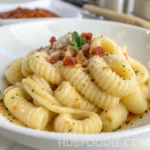
Gnocchi Noodles Recipe
- Prep Time: 30 minutes
- Cook Time: 10 minutes
- Total Time: 40 minutes
- Yield: 4 servings
- Category: Main Course
- Method: Boil (with optional pan-fry)
- Cuisine: Italian-Inspired
- Diet: Vegetarian
Description
Homemade gnocchi noodles made with potatoes, flour, egg, and salt. Soft, pillowy dumplings that can be paired with classic Italian sauces or modern fusion flavors. A cozy, versatile dish that feels like comfort in a bowl.
Ingredients
2 pounds russet or Yukon Gold potatoes
1 1/2 cups all-purpose flour (plus extra for dusting)
1 large egg (optional, see notes)
1 teaspoon salt
Extra: olive oil or butter for pan-frying
Instructions
- Cook the potatoes: Boil with skins on until fork-tender, or bake until dry and fluffy.
- Peel and mash: Use a potato ricer or fork for a smooth texture. Spread mashed potatoes onto a floured surface.
- Mix the dough: Add salt, egg, and about half the flour. Gently fold together, sprinkling in more flour until the dough is soft but not sticky.
- Shape the noodles: Divide dough into sections, roll into ropes about 1 inch thick, and cut into ¾-inch pieces. For noodle-style gnocchi, cut longer strips.
- Cook the gnocchi: Drop a few at a time into a large pot of salted boiling water. Cook until they float to the surface, about 2 minutes.
- Serve: Toss immediately with your favorite sauce, or pan-fry in olive oil/butter until golden.
Notes
For vegan gnocchi, omit the egg and replace with 1 tablespoon olive oil or 2 tablespoons aquafaba.
For gluten-free gnocchi, swap the flour with a gluten-free flour blend.
Freeze uncooked gnocchi in a single layer before transferring to a bag. Cook directly from frozen.
Pair with marinara, pesto, cheese sauces, or fusion flavors like sesame and soy.

